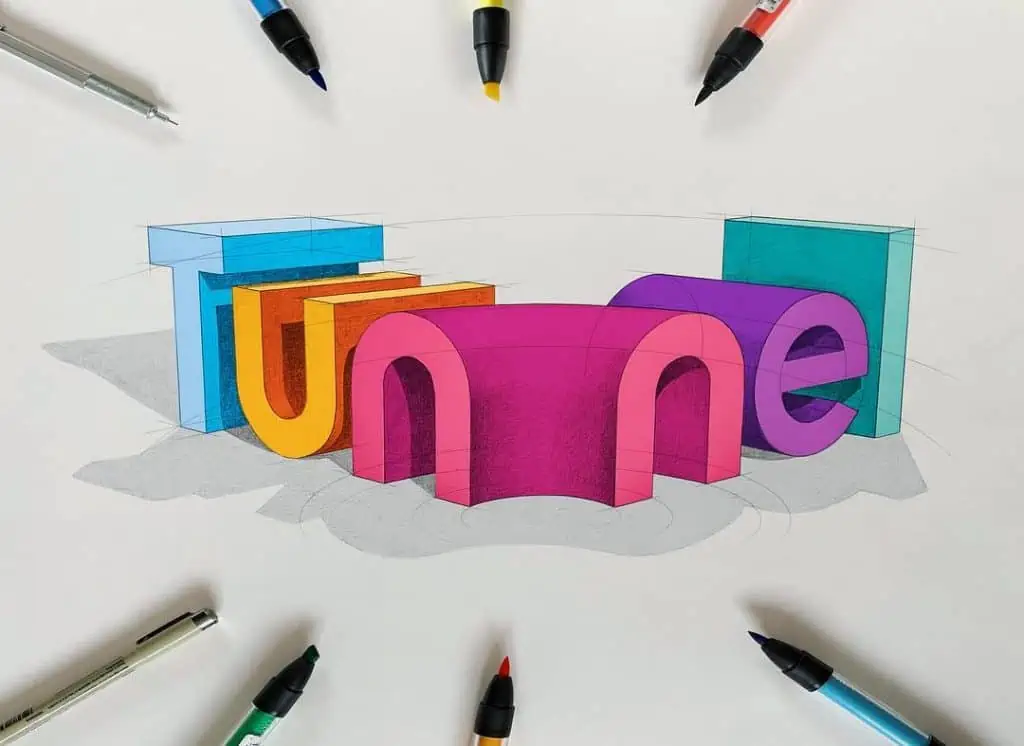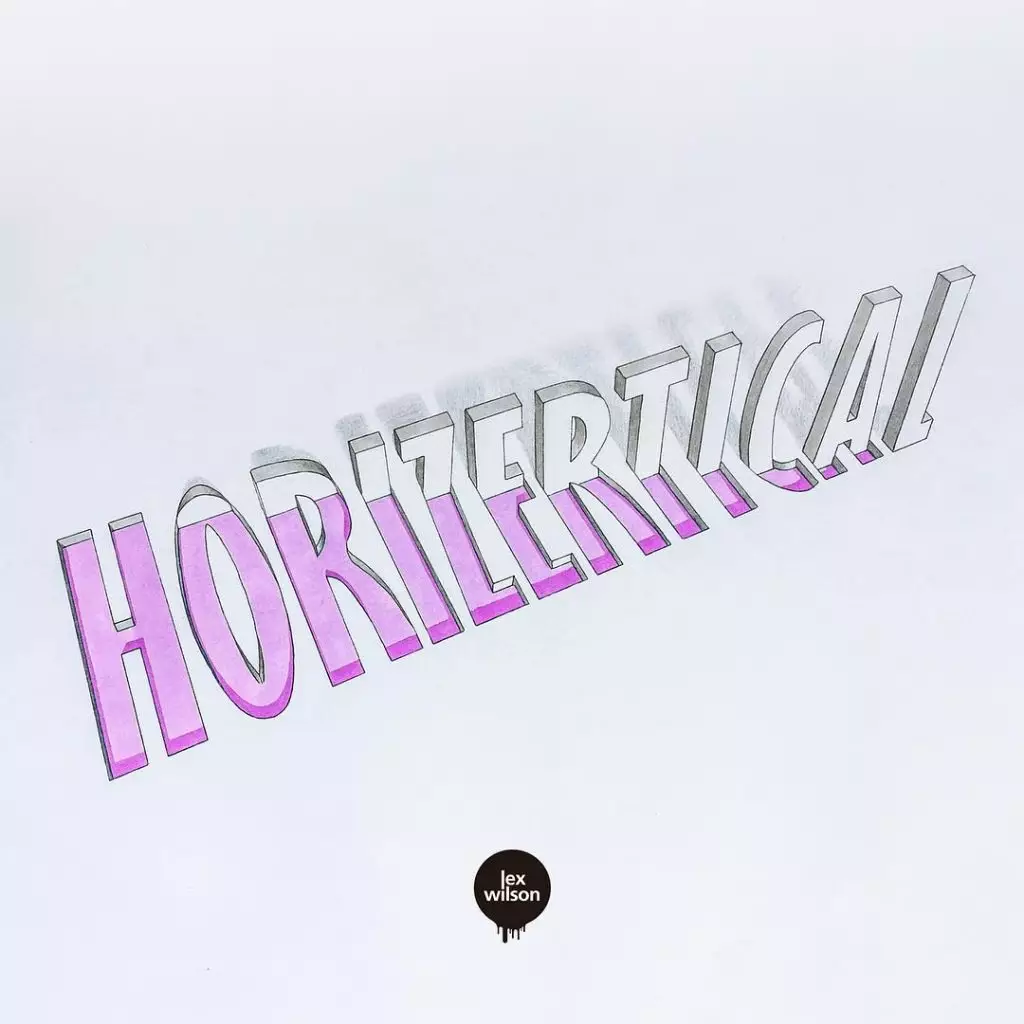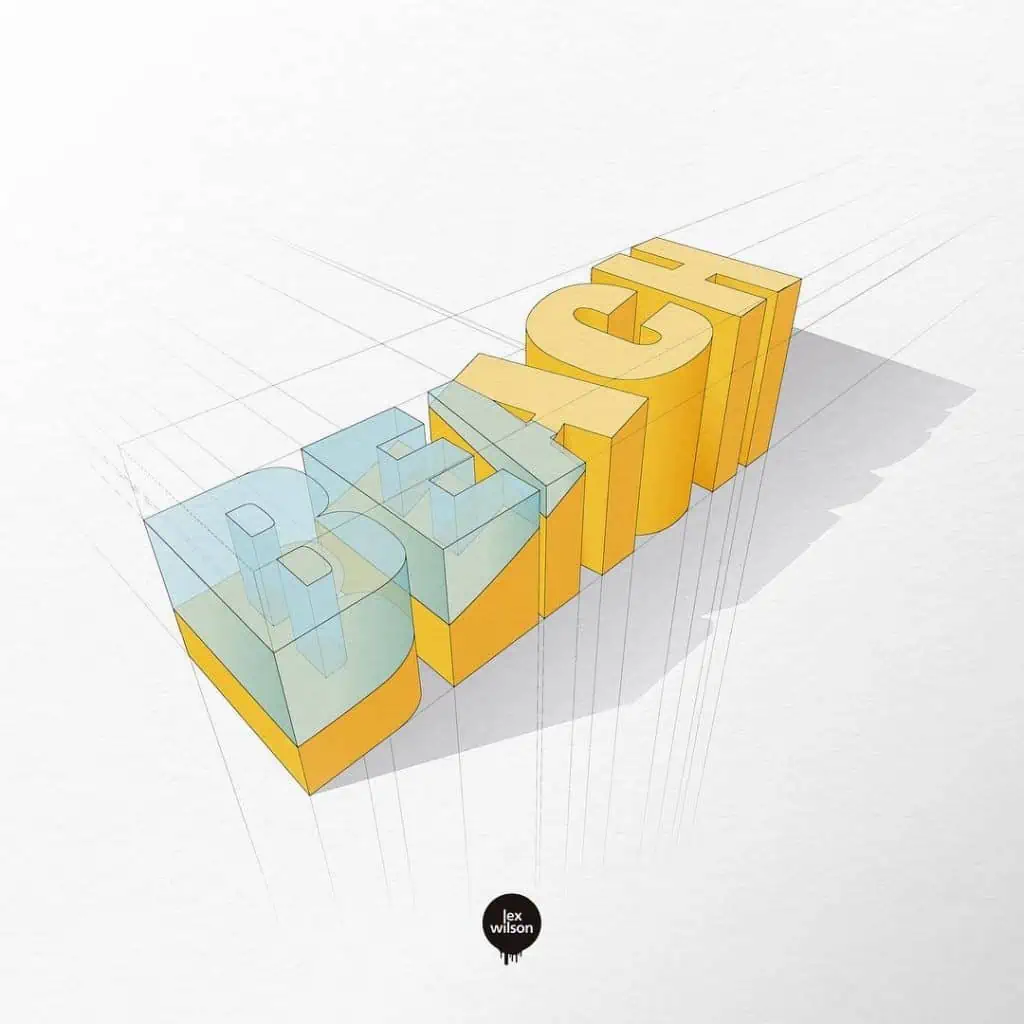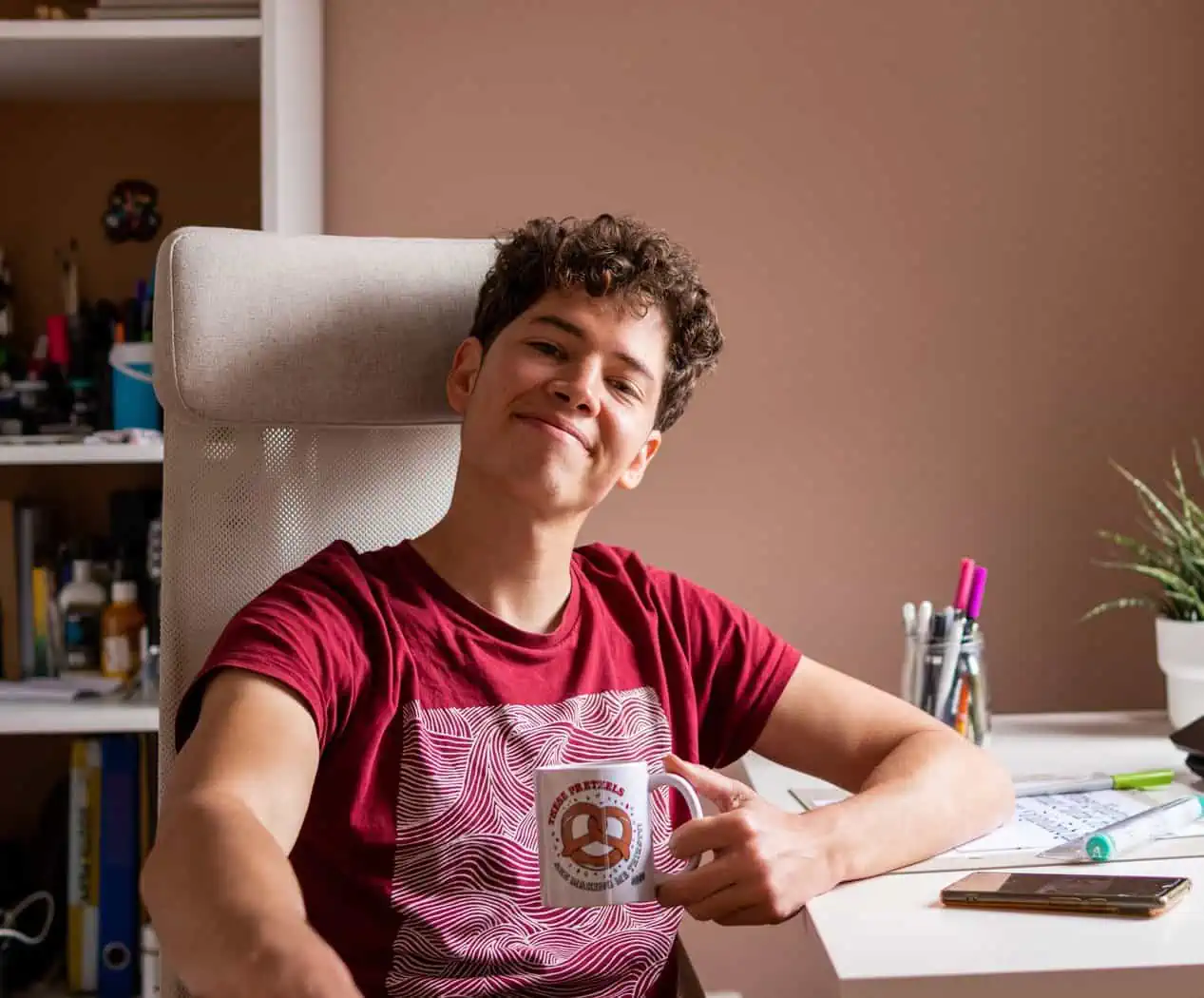This post and the photos within it may contain affiliate links. If you purchase something through the link, I may receive a commission at no extra charge to you.
The interview series continues!
I’ve had the pleasure to chat with an insanely talented artist that truly stands out from the crowd with his creative artwork.
An artist that keeps creating mind-bending and jaw-dropping pieces on a regular basis.
Ladies and gents, I am REALLY excited to share this interview with the type wizard – Lew Wilson.
Enjoy!

1. Who are you, and what do you do? What’s your background?
My name’s Lex, and I’m a visual artist – a purposely vague title that’s loose enough to encompass the various things I do.
I’m lucky to be able to do what I love every day (it hasn’t always been that way though!).
I split my time between my’ day job’ as a type-based graphic designer and my freelance work as a typographer/illustrator.
I studied product design after college, which had a module on drawing in 3D – but mostly I’m self-taught.

2. How did it all start? How long have you been drawing letters?
I’ve been drawing things in 3D since I was really young – impossible space-vehicles, building-scapes, trains stretching into the distance and rooms in perspective.
I had loads of books on Escher, and my mum had a print of his ‘Penrose Stairs’ in the house, which always fascinated me.
I started applying those stair motifs to letters in about 2009.
I had this idea about the word ‘help’ made of stairs like Escher’s ‘Relativity’ piece.
It wasn’t as mind-bending as his, but it’s definitely where all my work started.

3. What inspires you to create mind-bending typography artwork? How do you come up with these concepts, and how does your creative process look like?
I’m interested in semantics – how a word evokes images in mind.
I like double entendres too – how some words and phrases can mean two different things.
I want to find little visual hacks from these weird things in the language.
Since I got a dog, I’ve been walking miles every day, and I use this time to just play with ideas in my mind – free from distractions and out in the open air.

Let me break down my process in a few step –
I usually have the idea fully formed before I put pencil to paper – I’ll rarely experiment with a concept on paper – it’s almost always done in my head first.
1) I start by sketching the idea out roughly – to find an angle that will give me exciting composition or geometry.
2) I set up vanishing points in 3-point perspective, and I get to work in pencil – this is a working document that will serve as a guide for my final piece, it has all my construction lines, notes etc…..and mistakes.
3) I experiment with potential lighting positions, which affects shadow placements. I try to use lighting placements that give me bold tonal values but also throw the cast shadows into exciting positions.
4) Once my working piece is where I want it, I use a light box to reproduce the piece fresh, without all the mistakes! I reproduce the outlines but not the shading at this point.
5) I ink the outlines and erase all the pencil lines – using an eraser both get rid of the pencil; it also takes some of the weight out of the pen (Micron 0.05).
6) I use markers to render the color, building up layers to give the forms their tonal values.
7) I use a pencil to add the shading and cast shadows, according to where I set my light position in my working piece. For rendering the shadows, one thing I do that I haven’t seen done a lot elsewhere is to cast shadows onto my letters – sign-makers and other letterers tend to cast shadows just onto the ground plane – this works really well for punchy signs – but in a fine art context.
I think casting them on the letterforms themselves adds some extra realism and opportunities for some weird shapes and contours in the piece.
8) Finally, I photograph the work (I like to shoot rather than scan – I think it shows the paper tooth and helps retain some of that freehand quality).
I open the image in photoshop and fix the levels, white balance, and retouch places where I’ve gone over the lines (it’s inevitable!).
4. What sort of educational resources do you recommend for beginners?
My work is technically quite basic – it relies on techniques that are really well established, and there are LOADS of books and tutorials on 3-point perspective, pencil shading, shadows, rendering light, etc.
My artwork is really about being playful with words and their meaning, and so whenever I hear or read something (often it’s overheard in a conversation, something on a TV show, a clever hip-hop lyric or just something that pops into my kind).
I write it own and then let it marinate in my mind for a while to see if it leads anywhere.

5. Could you name some artists that influenced you in developing your own unique style? Also, artists that keep inspiring you today?
In terms of influences in my style, Escher is really my only influence.
His technical skill is ridiculous, and his use of 3D is fantastic.
But for me, the real charm is his layering of illusion over realism.
I try to avoid looking for inspiration in other’s work because I fear their ideas will find their way into my work without me realizing!
It happened once, and someone called me out on it.
It wasn’t at all intentional but I’d obviously seen something, and without knowing it, I’d created a really similar thing.
I felt terrible and also felt unoriginal.
So I try to limit my exposure to other letterers. I take inspiration from those other sources I mentioned above though – spoken word, hip-hop, even the dictionary or thesaurus!
That said, there are a few artists on IG who are a massive inspiration for slightly different reasons:
@signsofpower (Vanessa Power) – absolutely love how she uses color – both her color choices and the application at a colossal scale.
I’d like to take my work to a larger size and make it more colorful.
@jasonnaylor (Jason Naylor) – love how consistent and unique his work is, and again, I love how he uses color.
His style of vivid color against a black b/g is uniquely his, and I instantly recognize it.
@Jamesllewis (James Lewis) – I doubt there are many letterers on IG who don’t know who James is.
Again, I love his use of, but I also think the way he’s combined his practical work with workshops – empowering others to enjoy lettering – is inspiring.
He has a real skill for engaging his audience, and as someone with a comparatively tiny following, that’s a great inspiration to me.
The above are just a few of many inspirations!

6. Thanks to the internet and social media platforms, there are a lot more opportunities for artists today. What do you consider to be some of the pros and cons of the internet and social media platforms?
The internet and social media have revolutionized what it means to be an artist (by artist I mean anyone producing creative content).
Anyone creating content these days is necessarily fighting a battle between making their content accessible (and therefore getting maximum exposure), and monetizing their content as some reward for the time and effort it takes to be creative.
Generally, your content has to be free to generate interest and a following in you and your work.
But people rarely want to start paying for something that was initially free – in fact, free things are perceived as being of little or no monetary value.
So it’s a complex dynamic that all content creators are faced with these days – in music, in visual art, in podcasting – everywhere.
The upside to this though is an ability to be part of a community that can give you feedback on your work, where you can engage with your audience in a way that you could never have done before.
People can be ambassadors of your work by sharing it, you can be much more expressive about the background to your work, and you can be part of communities in which you can develop yourself, your practice, and others.
So on balance, I think the internet is definitely a positive thing.
I’d like to see options for subscription-based art content which in turn reinvests in its creators – think Netflix model for television production, or Luminary for podcasting, Audible for literature, etc.
Why not? There’s a question.

7. In your opinion, what does it take to become a full-time lettering artist? Monetizing and making a living out of your creative skills.
I’ve always felt that if you’re passionate about your work and you do it with love, you’ll produce something of value to people.
People can distinguish work made with love from the rest – it stands out.
If you find your niche, your little spot in the world of art, and keep developing your ideas in that area, you can become an expert.
For me, the process has gone like this:
I’ve kept my style quite specific – I don’t try to do too much or be too varied.
I want to try to be an expert in a narrow field.
I’ve shared everything I’ve done without the expectation of being paid for it.
Doing art and being creative is its own reward for me.
Art blogs have noticed my work – maybe because it’s been created with love, perhaps because the style is easily contained – I don’t know.
But all my freelance work has come from art directors or editors seeing my work shared online (for free) and getting in contact.
There are lots of different channels to monetize your work as an artist – you can sell physical pieces, you can get commissions (my primary source of income), you can license your work to distributors or manufacturers, organize regional workshops and tutorials in physical spaces (charging for your time), or deliver instructional content via online platforms.
Like any creative pursuit, there are often two bright sides to the story – the creative work and the business work.
The challenge for today’s artists – especially those online – is to balance the two, because, without both, you’re either a business with no creative appeal, or an artist working for free.
I believe there’s never been a better time to make money from art though, to build a loyal following and to connect with people who love (and are willing to pay for) what you create.
And remember: the starving artist stereotype is bullshit.
You have to be confident that you’re worth something.
If you do, and you name a price, it will come.
Don’t sell yourself short.

8. At a certain point, we all deal with some sort of creative blocks (lack of inspiration), how do you deal with these situations?
I feel that creativity – real creative thinking – can be elusive and a bit luxurious.
It doesn’t work on a 9-5 basis – you don’t start thinking creatively at 9 and stop thinking creatively at 5.
It’s not like a tap to be turned on and off.
So when I find myself coming up with ideas, I try to push everything else aside and nurture them; I know it won’t last.
As artists, we have to take time out and not pressure ourselves to come up with ideas all the time.
I call that downtime, and it’s an excellent opportunity to work on social media, connect with your following, organize your content, research new techniques, etc. – all the essential stuff that can get left behind when you finally have an idea burning in your mind!
So if I have a creative block (often!), I use it as a time to do all the things I’ve been putting off.
Usually doing this admin-type stuff helps me get exposure to new ideas, reach new people, get a better sense for what I’ve produced and where I might go next – so it’s not wasted time.

9 . What sort of tool or technique do you admire, and you would be interested in learning?
I want to create wall murals.
Huge murals in the paint.
There’s nothing I’d rather do.
If I could take my work and produce it in the way @jasonnaylor does, I’d feel like I’ve turned a massive corner in my creative life.
That’s why I’ve listed him as a major inspiration!
I’d also really like to see what I could do using a tablet, and go digital for a while.
I’ve seen so many artists using procreate and other digital tools to create fantastic work.
The game has definitely changed in the last 5 years; there used to be a clear line between what was hand-drawn and what was digital – but new digital tools have changed all that.
I use Wacoms but never really found them as tactile as a real pencil; I guess I’m just a bit old school.
But I’ve never tried procreate, and I’m really keen to see how I might use it.

10. If you could go back in time and avoid some of the mistakes you were making as a beginner, what would they be?
Most people know that the most successful people in life are the ones who’ve made the most mistakes.
So I don’t really regret anything.
In the early days, I’d give my work away for nothing – some sharks published it in printed books and sold merchandise using my work –
Maybe I regret not being savvier or holding them to account, but you only have so much energy, and mine was being spent on experimenting with my ideas.
I tend not to dwell too much on my mistakes, really.
There are letterers out there with massive followings and making loads of money – I’d love to be in that position – but my priority has always been about maintaining pure creative freedom and not about popularity or money.
If I can make time to experiment with my ideas, then that’s my idea of success.
One mistake I guess I’ve made is not producing much tutorial content.
Lots of people ask how to do my work, but I tend to prefer working through new ideas than creating tutorials, etc.
I think tutorials could be a really great way to give back to those people who’ve really supported my work over the last few years.

11. Finally, a slightly different question – if you could change one thing in the world today, what would it be?
I’m from the UK, and recently, most of the funding for arts-based education and initiatives has been cut massively.
There’s obviously a strong political undercurrent to this, but I find it alarming that the arts are always the first thing to take the financial hit in times of austerity.
I really believe that a strong economy relies on creative teams and individuals.
I think politics should embrace soft power, the power of culture, and creativity to influence and inspire people, to find solutions to the world most intractable problems, to light the way in a relentless dark.

Be sure to check out Lex’s other online platforms!
About the author

Hey, I’m Max Juric, and I’m deeply passionate about calligraphy and hand lettering.
I’ve spent years honing my skills in the art of lettering, working with hundreds of clients from all over the world on design projects such as logotypes, branding, custom lettering, murals, and more.
But my journey doesn’t end there. I’ve also dedicated myself to sharing my knowledge and expertise with others, creating a wealth of resources including tutorials, articles, and podcasts.
It’s been incredibly rewarding to see thousands of people engaging with my content each month. Knowing that I’m helping fellow enthusiasts grow and develop their skills makes me really happy.
Welcome to Lettering Daily, your hub for all things lettering and calligraphy. Whether you’re a seasoned pro or just starting out, I’m here to inspire and guide you on your lettering journey. Stick around, and let’s explore the world of letters together!

I feel like I have been living under a rock for not knowing Lex’s work, so amazing! Love the interview 🙂
hahaha! Well, at least now you know 😀 His work is truly magical.
WOW – such an impressive work!!!!
many ♡ ly greetings sent by
Sabine from WO(rms) in Germany
Thank you, Sabine!
Loved it! I was always blown with the works Lex creates and admire his amazingly unique style. Thank you Lex for sharing you thought process and work process.
Thank you, Ekta! Really glad to hear that you enjoyed the interview 🙂